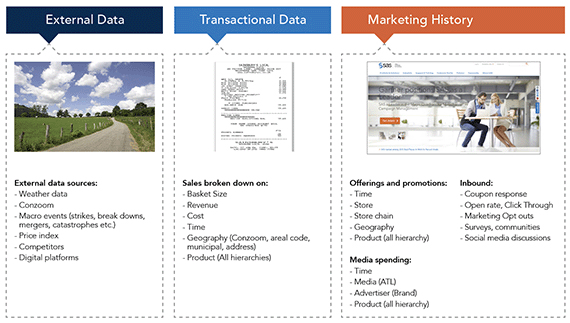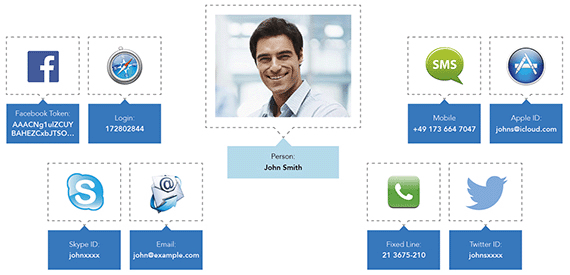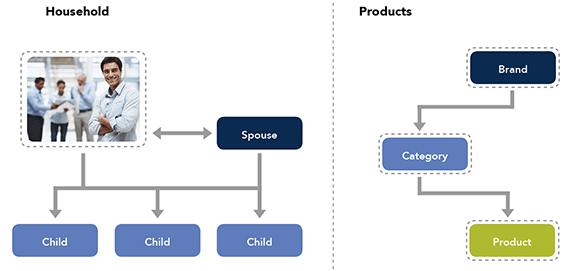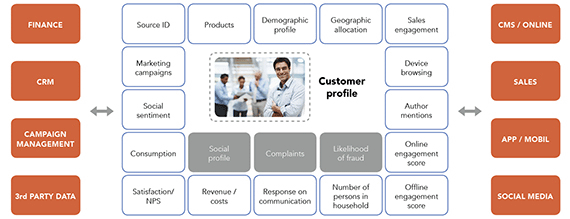Following my latest blogpost on the subject of executing omni-channel strategies, the first step is to obtain a greater overview and understanding of your customers.
In recent years, the massive increase in data volumes and the variety of sources have completely changed the concept of customer profiles for most companies. From a marketer's view, this has created what we could refer to as a ‘big data challenge’ in which it becomes very complex to gain an overview of individual customers across multiple platforms and contact points and embed the digital data residing here.
Extensive benefits can be gained from working with these types of master customer profiles, including greater effect of customer interactions and efficiency relating to the underlying processes.
In my experience, master customer profiles can be established through four sets of activities:
- Identify customer data
- Connect customer identifiers
- Establish data hierarchies
- Build customer profiles with automated data flows
Activity 1: Identify customer data
The initial activity is to identify and gather customer data located internally and externally. Internal sources are often scattered across the organization, and valuable insights into customer demands and market trends can be derived from these data. Hand in hand there are a great variety of external data sources available such as social media, competitor activities, demographic profiles etc.
Figure 1 illustrates different data sources – and depending on whether they are internal or external, the volumes and variety of sources create big data challenges to which we need a method of structuring data in an intelligent way. This is why it becomes necessary to focus in on the customer identifiers.

Figure 1: Examples of internal and external data sources. With the increasing number of digital platforms and customer engagement, a much wider range of rich data sources is available.
Activity 2: Connect customer identifiers
With the explosion of digital platforms, customers have a wide range of identifiers beyond the traditional ones, i.e. accounts or loyalty memberships. In order to gain a complete picture of the customer, we have to commence the work on gaining a picture of our customers across these platforms. This will provide access to new data, more arenas for interactions as well as understanding of the synergies and mechanism behind these.
Figure 2 shows a number of different digital platforms and identifiers which we need to understand and link together. Once these have been linked, we need to build customer profiles.

Figure 2: Examples of various identification profiles linked to an individual customer. The picture expands continuously as new digital platforms emerge.
Activity 3: Establish data hierarchies
Once we have a clear view of the data available at present and the connection between the different identifiers related to each customer, the next step is to create the master level – or data hierarchies.
Several types of hierarchies exist such as household level, product level and customer level. Household level is key in most industries, as we need to understand e.g. which customers who have already purchased a product from us and who have not. Figure 3 illustrates this.
An example could be an insurer who wishes to understand which customers do not yet have a household insurance. Looking only at customers without an insurance is not sufficient in this aspect, as it does not take into account which customers live together. You might end up wasting marketing investments and compromising contact policies by promoting this to customers already covered through their spouse.
The identification of stakeholders in a household can provide additional insight, e.g. for segmentation purposes.
Another relevant hierarchy to work with is companies that have either several brands or sub-organizations. As brands can have different underlying categories and even more products, the complexity can often be substantial. As we want to obtain an overview of our relations to customers and potentials for cross- and up-selling, the establishment or inclusion of product hierarchies are important.
Once the mapping is done, we cannot rest on our laurels. As part of the process of generating insights, we need to be able to work actively with the mapping on a continuous basis. More on this subject in my next blogpost.

Figure 3: Examples of different types of hierarchical levels that are relevant when establishing and working with customer profiles. The most common ones are on household and product level.
Activity 4: Build customer profiles with automated data flows
Once we have an overview of our data, we can start to develop the bridges between the different systems. I prefer to work with virtual layers, rather than commencing a data warehouse project. As data tends to change over time, we need a flexible foundation to work with – a good example is actuality (look at e.g. fax numbers). As some data sources such as individual customer behavior on websites can provide extensive data volumes, we need to consider storage. Storage options have changed significantly brought forth by a little yellow elephant.
These types of customer profiles have also been named DNA strands by some people, as you might picture all these data as genes on a strand; all connected to each customer enabling us to distinguish them from one another.
What I have found significant in this aspect is that the data bridges need to be automated, and as a key element in terms of working omni-channel – this needs to happen in real time. This demands a change in the old siloed infrastructure in which data flows back and forth in a continuous flow – running data quality processes, running propensity scores, checking contact policies etc. As customers interact with us at all times, we need to move beyond nightly batches and into a world where data is kept fresh at all times.
Figure 4 illustrates this virtual data layer with various data from different sources summing up the customer profile – and with seamless integration in real time illustrated by the arrows.

Figure 4: Example of a flexible data foundation drawing upon data from various sources – maintained in real time for optimal customer interaction in any channel at any time of the day.
Start out building the foundation
Building customer profiles is a key step in terms of executing an omni-channel strategy – and the one, which often demands the greatest effort. It lays the foundation for everything we do as it provides insight into both our customers and markets, internal processes and organization – in general, the current possibilities and limitations.
As I explained in my previous blogpost, the process of executing an omni-channel strategy is an iterative process – and this goes for the individual steps as well. Building customer profiles is no exception as my experience shows that new data continues to appear either from within the organization or externally through e.g. enriched data as well as new identifiers.
For this reason, this step is what I recommend as the first when commencing this type of journey. Data will always be key in any type of project, as it defines the possibilities as well as limitations. To that, any marketing or sales concept should always be validated and supported by facts, which is why I always suggest including data exploration as part of the creative processes.
